Relays
Relays are important devices used in various applications to control one circuit through another separate circuit. Browse our inventory below.
-
 Allen-Bradley
Allen-Bradley700-TBR24X: Allen-Bradley Term Block Style 24V 1 Pole Gold Relays
- Model #:
- 700-TBR24X
- UPC #:
- 61132078352
- Part #:
- 700-TBR24X
- New/Surplus $ 16
- Refurb. Price $11 Save up to $ 5
- Repair Price $8 Save up to $ 8
-
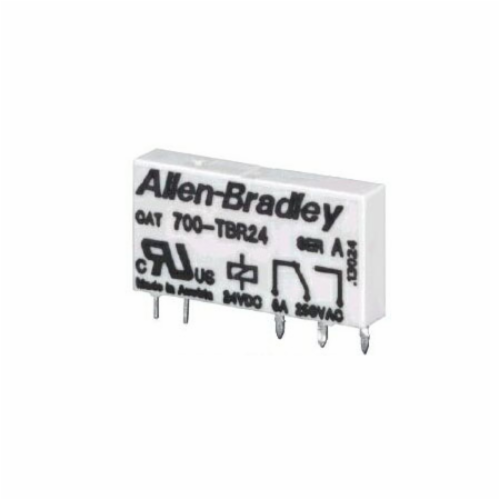 Allen-Bradley
Allen-Bradley700-TBR24: Allen-Bradley Term Block Style 24V DC 1 Pole Relays
- Model #:
- 700-TBR24
- UPC #:
- 61132051730
- Part #:
- 700-TBR24
- New/Surplus $ 14
- Refurb. Price $10 Save up to $ 4
- Repair Price $7 Save up to $ 7
-
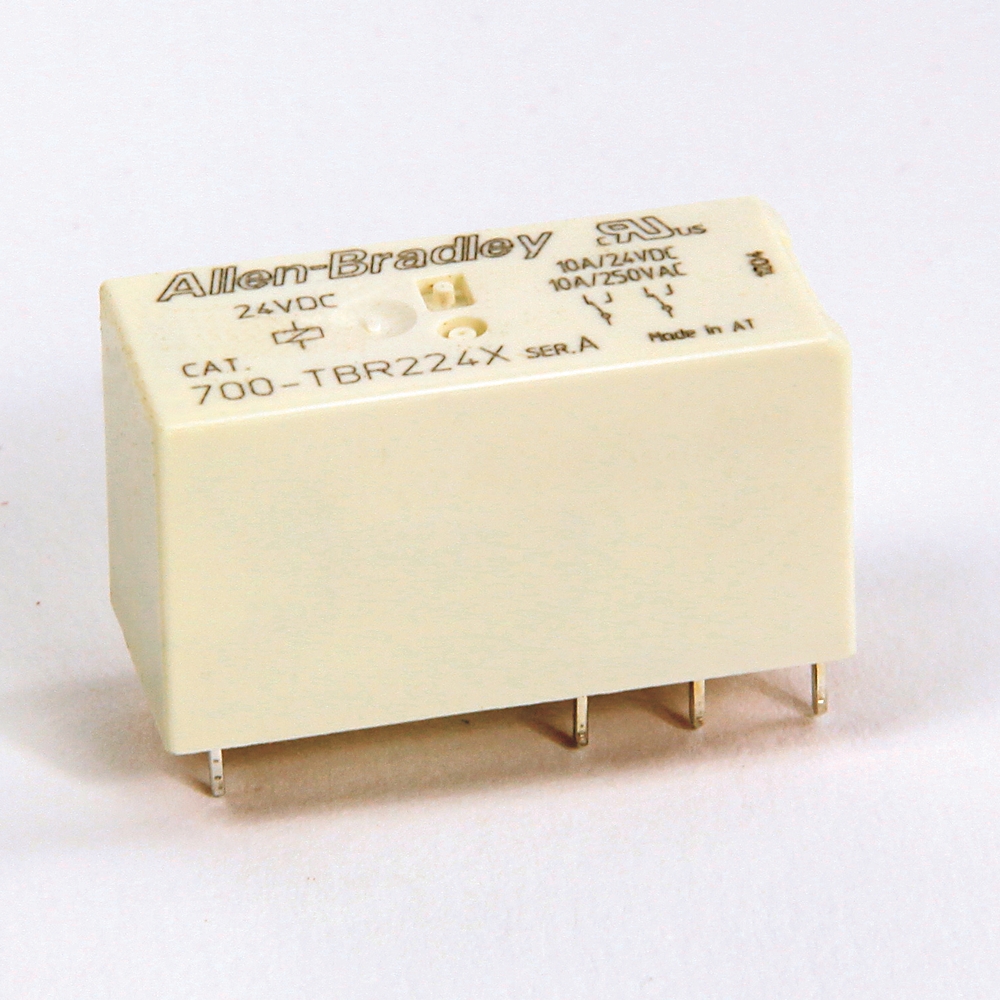 Allen-Bradley
Allen-Bradley700-TBR224: Allen-Bradley Term Block Style 24V DC 2 Pole Relays
- Model #:
- 700-TBR224
- UPC #:
- 66207428363
- Part #:
- 700-TBR224
- New/Surplus $ 16
- Refurb. Price $11 Save up to $ 5
- Repair Price $8 Save up to $ 8
-
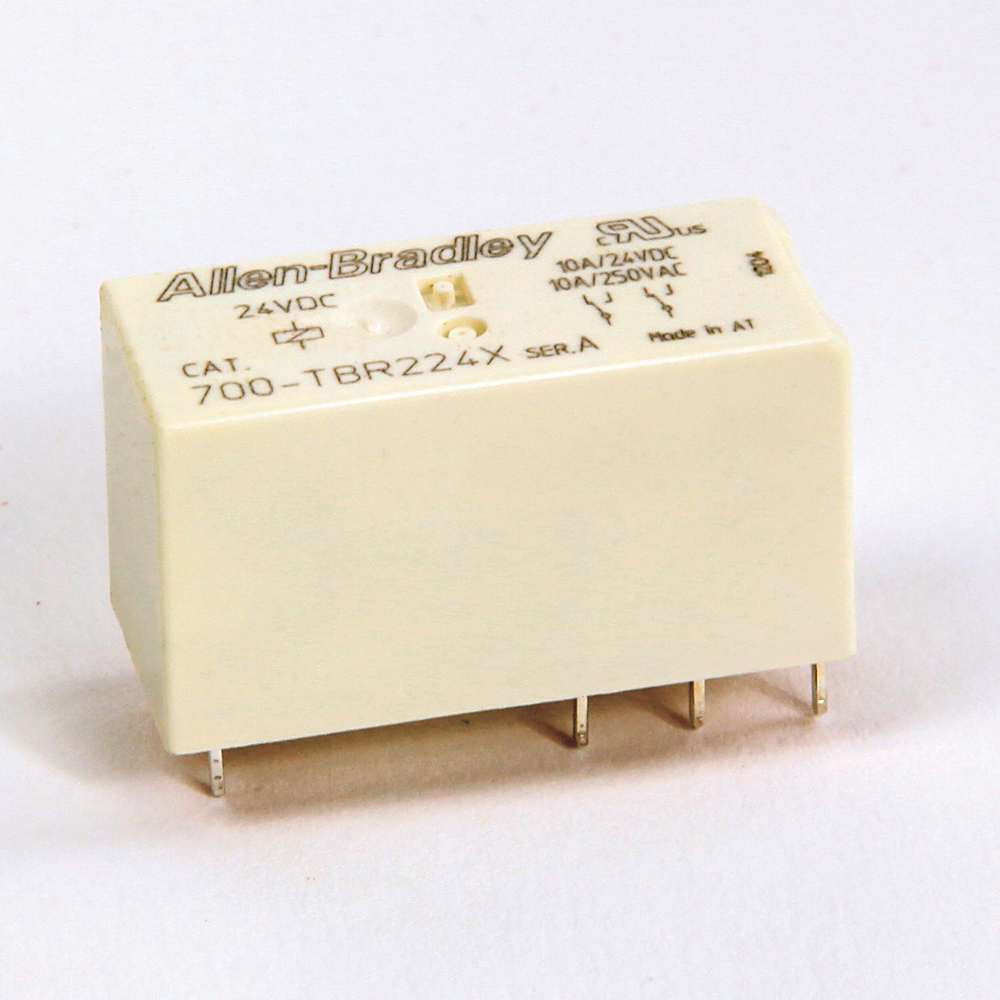 Allen-Bradley
Allen-Bradley700-TBR224X: Allen-Bradley Replacement Relay
- Model #:
- 700-TBR224X
- UPC #:
- 66207428366
- Part #:
- 700-TBR224X
- New/Surplus $ 18
- Refurb. Price $13 Save up to $ 5
- Repair Price $9 Save up to $ 9
-
 Allen-Bradley
Allen-Bradley700-TBR2110: Allen-Bradley Replacement Relay
- Model #:
- 700-TBR2110
- UPC #:
- 66207428365
- Part #:
- 700-TBR2110
- New/Surplus $ 20
- Refurb. Price $14 Save up to $ 6
- Repair Price $10 Save up to $ 10
-
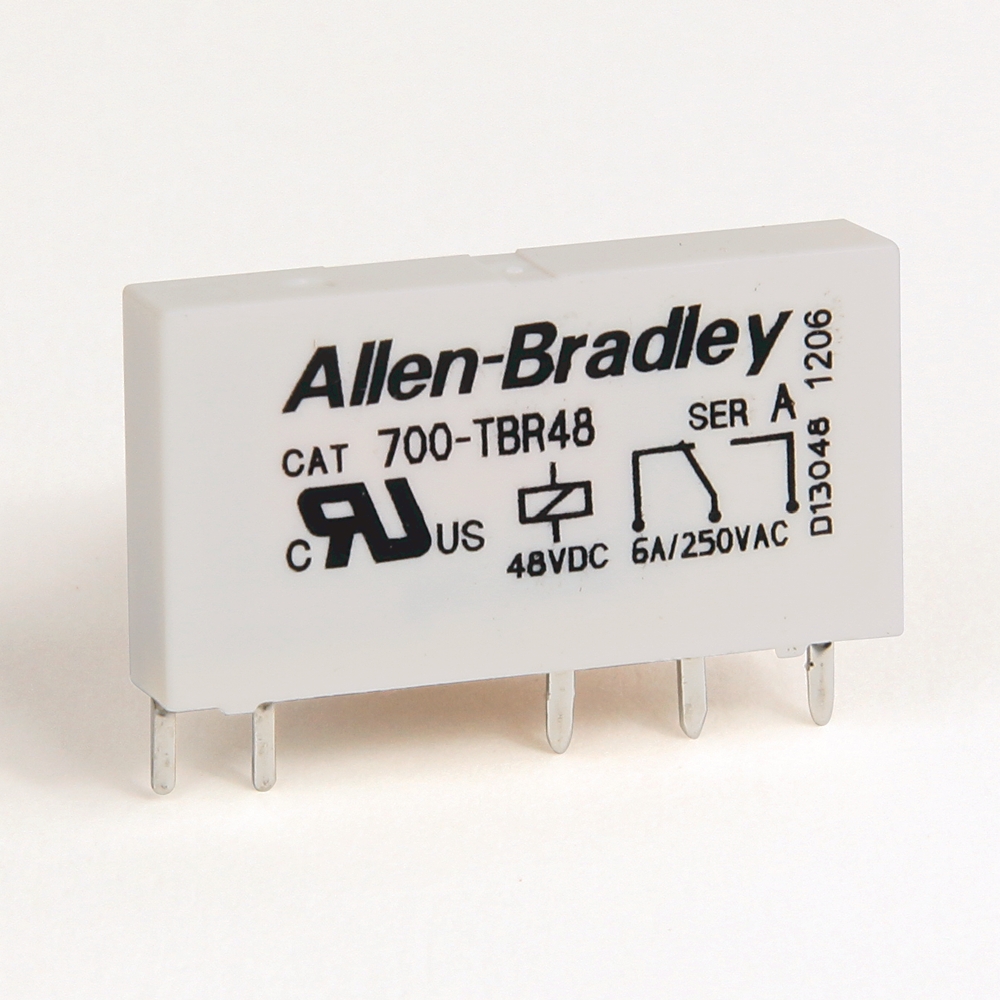 Allen-Bradley
Allen-Bradley700-TBR12: Allen-Bradley Term Block Style 12V DC 1 Pole Relays
- Model #:
- 700-TBR12
- UPC #:
- 61132053496
- Part #:
- 700-TBR12
- New/Surplus $ 15
- Refurb. Price $11 Save up to $ 4
- Repair Price $8 Save up to $ 7

What Are Relays?
A relay is a type of switch or amplifier powered by an electric current. It allows one circuit to control another without the two circuits physically connecting. Relays accomplish this by using a magnetic field or electrical signal to trigger a second circuit to change from an open position to closed or vice versa. In effect, the relay can either turn on or turn off a device.
Purpose of Relays
Relays are invaluable tools since they allow one circuit to control another. More specifically, they enable circuits of differing voltage levels to interface with each other.
This ability is useful since many sensors are electronics that produce small electric currents. When your company needs these delicate sensors to drive devices with larger currents, you need something to bridge the gap. That’s exactly what a relay does. A relay allows electronic devices that run on low power, such as computers or microcontrollers, to control high-powered electronic appliances or machines, like lights, ceiling fans, or industrial machinery.
For example, an electronic thermometer could prompt a space heater to turn on by using a relay since the small electric current in the thermometer would not be enough to power the heater on its own. Relays also have many applications in automotive manufacturing. They allow electronic sensors to turn on windshield wipers or headlights, sound warnings to buckle up, or set off security alarms.
Relays can also use one circuit to control multiple other circuits. This means you can use one sensor to turn on multiple devices at once.
Some relays are considered protective relays because they detect faulty or abnormal conditions in a circuit and initiate appropriate control circuit action. In many instances, this means triggering a circuit breaker.
How Relays Work
The basic functionality of a relay is quite simple, and the whole process takes just a fraction of a second. How a relay works partly depends on its operating principle, which we’ll discuss more below. Here, we’ll focus on the electromechanical relay. The relay sits between two circuits, the second being larger than the first.
When the first circuit provides an electrical current to the relay, a coil in the relay produces a magnetic field. This field causes an armature to move contacts, either together to close the second circuit or apart to open it.
Circuits that remain open by default until the relay causes the circuit to close are “normally open” (NO) relays. When the power source is removed, a spring in the relay pulls the contacts apart, opening the second circuit and turning off the end device.
NO relays are the most common type, but some are “normally closed” (NC). With these relays, the contacts remain connected by default until the electromagnetic field produced by the relay pulls the connectors apart, shutting off the end device.
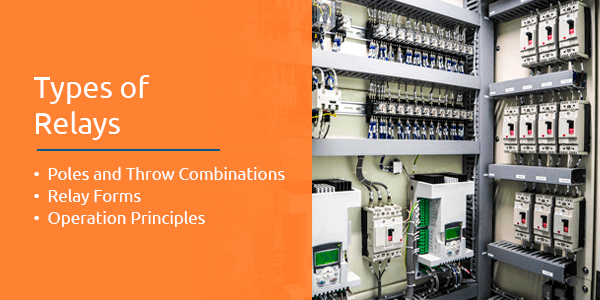
Types of Relays
Though all relays share similar functionalities, relays come in numerous types to suit different applications. The various types of protection relays can be defined by aspects of how they’re made or used. Let’s look at some common ways we can divide relays by their different categories.
Poles and Throw Combinations
One way to classify a relay is by its poles and throw. Poles refer to the number of switches in a relay, and throw refers to the number of positions each pole can conduct in. This is the number of circuits each pole can control.
The simplest example is a single pole single throw relay (SPST). An SPST relay can switch a single circuit on or off. In a single pole double throw (SBDT) relay, the relay can only control one circuit at a time. However, by closing one circuit it will open the other, and vice versa. Other types of poles and throw combinations include double pole single throw (DPST) and double pole double throw (DPDT).
Relay Forms
Another way we can classify relays is by their contact configuration, or “form.” Various relay forms are labeled with a letter of the alphabet. For example, a Form A relay is an SPST relay that is normally open by default. A Form B relay is an SPST relay that is normally closed by default.
The most common forms are A, B, C and D, but there are also more. These are labeled with other letters in the alphabet and take on more complex configurations.
Operation Principles
One of the main ways you’ll see relays classified is by their operation principles. Some main types of relays include:
- Electromechanical: An electromechanical relay uses a coil that creates a magnetic field when it receives a current. The magnetic field attracts an armature to push contacts together or apart, thereby closing or opening the second circuit. When the power to the coil cuts off, the magnetic field disappears, and a spring returns the contact to its former position. Electromechanical relays can handle exceptionally large currents.
- Solid-state: Solid-state relays do not have moving parts. Instead of mechanical components, they use semiconductors. In this case, an electrical current causes an infrared light to come on. A semiconductor senses the light and converts that signal into an electrical signal, which opens or closes the second circuit. Solid-state relays are typically smaller than other types and can switch circuits on or off more quickly, making them especially useful in computers.
- Reed: Like electromechanical relays, reed relays also employ an electromagnetic coil. However, rather than moving mechanical contacts, the magnetic field attracts two metal blades called reeds. These reeds are contained in a gas-filled glass tube. Similar to solid-state relays, an advantage of this model over electromechanical types is a lack of moving armatures. That means the relay’s parts won’t wear out.
Differences Between Relays and Circuit Breakers
Sometimes relays are compared to circuit breakers because they are both a type of switch. However, the basic function and application of these devices are different. Fundamentally, a relay allows one circuit to control another, while a circuit breaker interrupts the flow in a faulty circuit. It isolates a faulty circuit from another circuit or power source.
Like a circuit breaker, a circuit protection relay can help address a fault in a circuit. In this scenario, the relay senses the problem, while the circuit breaker isolates the faulty part of the circuit from the rest of the system.
Order Relays Online From Global Electronic Services
Relays are a crucial component in many equipment types and systems. Global Electronic Services offers a wide selection of relays to suit various applications. Browse through our selection to find the one that’s right for the job and request a quote today. If you’re unsure what type of relay you need or have any questions our experts can assist you with, call us at 877-249-1701.
